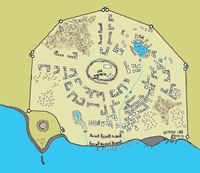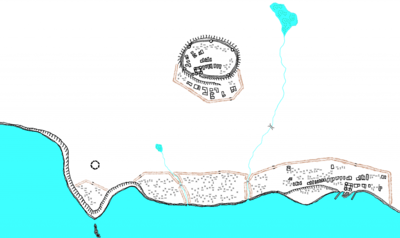Obsidian Bay, CY 515
| Country: | A Free Settlement |
| Leader(s): | Samuel "Battle Axe" Longriver, Johann the Destroyer, Robertson, Súlimëtasar |
| Population: | population::3,500 |
Contents
Details
- Population: 3,500 (60% human, 20% dwarven, 5% halfling, 5% half-elven, 5% gnome, 3% elven, 2% half-orc)
History
The Founding
The town that became Obsidian Bay began as a small settlement known as Griffins Landing. Its founders -- the Griffins Guild -- were an established adventuring guild in the city of Irongate when the Poor March was overrun by hordes of orcs, goblins, gnolls and other monsters. The creatures were fleeing the Hateful Wars, the combined elven and dwarves offensive against the humanoids dwelling in the Lortmill Mountains.
The onslaught overwhelmed the region's defenses, and its nominal protector -- the Principality of Ulek -- was powerless to stop the assault. Those who could fled the peninsula; those who could not, became slaves ... or food.
The civilized world did nothing as the Poor March fell. The stalwart heroes of the Griffins Guild had spent years fighting evil in a hundred different forms, from lowly goblins to soul-hungry demons. They could not let this new threat go unchecked.
The 80-adventurer strong guild rallied their followers, henchmen, and other supporters to form a 300-person strong strike force. They landed on the obsidian-sanded shores of the southeastern Poor March in a region once known as Storm Tower.
The area was selected for its navigable harbor, its proximity to potential farmlands, and its magical nexus. The Storm Tower, an ancient keep that was built atop the ruins of an ancient Flan stone circle, had long been the focus rumors about strange, mystical happenings. Research by the senior mage, Robertson, revealed that the rumors were true. The tower had been built upon a ley line, and controlling it could give the guild access to the power it needed to liberate the Pomarj. Secretly, Robertson also hoped it would provide the key to defending Oerth from the growing threat of demonic invasion.
The Griffins Guild guild landed on an early spring day -- Coldeven 10 -- of CY 513. They immediately engaged the Red Fangs, a murder of orcs that sacked Storm Tower during the Fall of the Poor March. After securing the tower ruins they established a defensive perimeter atop a nearby hill. The guild's spellcasters used their arcane and divine magics to erect stone walls augmented by hastily constructed wooden palisades.
They called their initial settlement Griffins Landing. After establishing a fortified beachhead at the shoreline, the guild began their reconnaissance of the peninsula. They identified threats -- particularly against those enclaves of dwarves, gnomes, humans, and halflings who were barely holding out against the invaders -- and dealt with them. Adventurers through and through, they also sought out ancient ruins, fallen castles, and lost caverns in hopes of finding treasure and magic. In doing so they discovered something unexpected: a sprawling dungeon complex with midnight black walls that they came to call the Obsidian Maze. All manner of monster lurked within the Maze: death cults, mind flayers, dragons, and even a beholder colony called the City of Eyes.
The threats were great, but so were the rewards. The Griffins Guild defeated the evils they found in the made and uncovered tremendous treasures. This additional wealth allowed them to fund the expansion of their new settlement including a true dock and permanent fortifications.
Rapid Expansion
Griffins Landing grew with the success of its namesake. Within six months the settlement's population had grown to 500 as the guild paid for laborers and skilled tradesmen to come to the town and build out its burgeoning infrastructure. Meanwhile refugees -- those liberated by the guild as well as those who had seen its flickering light -- began arriving in the city. A year after founding, it had a thousand inhabitants. It was the discovery of the Obsidian Maze, however, that truly put the town on the map ... and changed its name forever.
The Obsidian Maze was a thing of legend. The presence of an immense subterranean complex under the Pomarj had been rumored for centuries, but never found. When news of the Griffins Guild's discovery reached the larger world, it triggered a gold rush. Adventurers from around the Flanaess came to Griffins Landing to test their mettle against the legendary dungeon. The town's population surged to 2,500, then nearly 3,000 as more tradespeople arrived to support the adventurers. By 515, influx of refuges, thrill seekers, and profit-minded guilds had surged the town's population to 3,500.
It also change its name. Most of the newly-arrived citizens of the town behind the fortified walls that protected the city's fledgling water front. The city's defining characteristic -- it's obsidian sand beaches -- led the new arrivals to start calling the town "Obsidian Bay". Much to the surprise and dismay of the Griffins Guild, the name stuck.
Obsidian Bay was truly born.
City Overview
Governance
Political Leadership
The town's nominal leaders are the senior members of the Griffins Guild:
- "Battle Axe" Longriver (Human Fighter 14)
- Johann the Destroyer (Human Cleric 14, St. Cuthbert)
- Robertson (Human Wizard 16)
- Súlimëtasar aka "Willow Wind" (Elf Fighter 6/Wizard 8)
Griffins Guild is a noble, upstanding adventuring guild with the best of intentions that nonetheless is the victim of its own success. The initial landing and establishment of Obsidian Bay went well enough when it was just the Griffins Guild their loyal followers, but when others joined the cause governance became far more difficult.
When the first new recruits to the Griffins Guild, and members of other like-minded guilds showed up, they were bound together by a common cause of dealing with frequent humanoid and monster attacks. Their difficulties began with the arrival of the first refuges, who suddenly needed to be barracked, fed, and defended. This situation too was manageable as the guild used its connections to find people new homes or, failing that, jobs in the fledgling town supporting the war effort.
The discovery of the Obsidian Maze, however, opened the flood gates. Suddenly there was a legendary dungeon to be explored, and fame and glory to be won. Plus, the riches of a kingdom were to be had by liberating fallen mines, keeps, and towns. More opportunistic types began to arrive, and the tight-knit community of veterans found themselves hard-pressed to absorb them.
Now the town is a burgeoning 3,000 people, and still has no clear political leadership. Samuel "Battle Axe" Longriver, a good man with populist impulses, is being pressured by his cohort to take on the title of "Lord Mayor" and become the town's chief executive. In truth, he really just wants to be out in the field, fighting the good fight, saving the world, and kicking ass.
The mage Robertson is a man far more interested in exploring the magical puzzles of the Pomarj and countering the burgeoning threat of extraplanar invasions than he is in day-to-day rule. His arcane cult of personality is already talking about the need for a formal mage tower to unify the magical defenders of not just Obsidian Bay and Keoland, but Oerth itself! They ignore the troubles in the city and instead focus on rebuilding Storm Tower as their new headquarters.
There is one Griffin who seeks the uncertainty in Obsidian Bay and knows it must be tamed. His name is Johann the Destroyer, stalwart priest of St. Cuthbert. True to his faith, he argues that order and discipline must be established before the community descends into chaos. His followers -- with no mandate save that which they gave themselves -- patrol the streets of the frontier settlement, cudgels in hand, attempting to reign in the greatest of the frontier towns excesses. All the while Johann advocates for a more formal government, and pressures Longriver to establish the rule of law.
The elf lord Súlimëtasar, known to his human friends as Willow Wind, spends most of his time in the field fighting the humanoid menace with a cabal of like minded warriors, druids, rangers, and the occasional cleric. When his team comes sweeping back into town they are a chaotic force that temporarily offsets Johann the Destroyer's lawful impulses. The elf often meets up with his old friends, tells them of some new threat, and then together they head off into the wilds to deal with it, leaving the city leaderless for days, or even weeks, at a time.
Guild Leadership
It is not all chaos. Obsidian Bay would come to be known for its powerful guilds, and that impulse began with its founding. There are four major adventuring guilds and a dozen minor ones in the city. There are trade guilds for the major businesses in town -- blacksmithing, leather working, fletching -- and even some of the smaller businesses are starting to get organized. They have come together to form the Trade Council, the leader of whom is Victor Smith, a weapon smith known for his excellent battle axes. This group has taken it upon itself to set prices and establish trade rules.
Church Leadership
The Church of St. Cuthbert is the major religious force in town, though the religious diversity of the Flanaess is represented by a dozen smaller churches and shrines. Led by Johann, the church has 10 clerics and 30 billets (lesser clerics) as well as a few new acolytes being trained in the faith. Frustrated by the lack of secular law, Johann and his people have begun enforcing church law in the city. Most of these are common sense tenants (no murder, no theft) and the clerics have no trouble beating said common sense into adventurers with their cudgels. This is causing increasing tension in the city which is clearly Johann's plan -- he wants Samuel Longriver to take on formal leadership of the city, and he's prepared to brow-beat the populace into making him do it.

